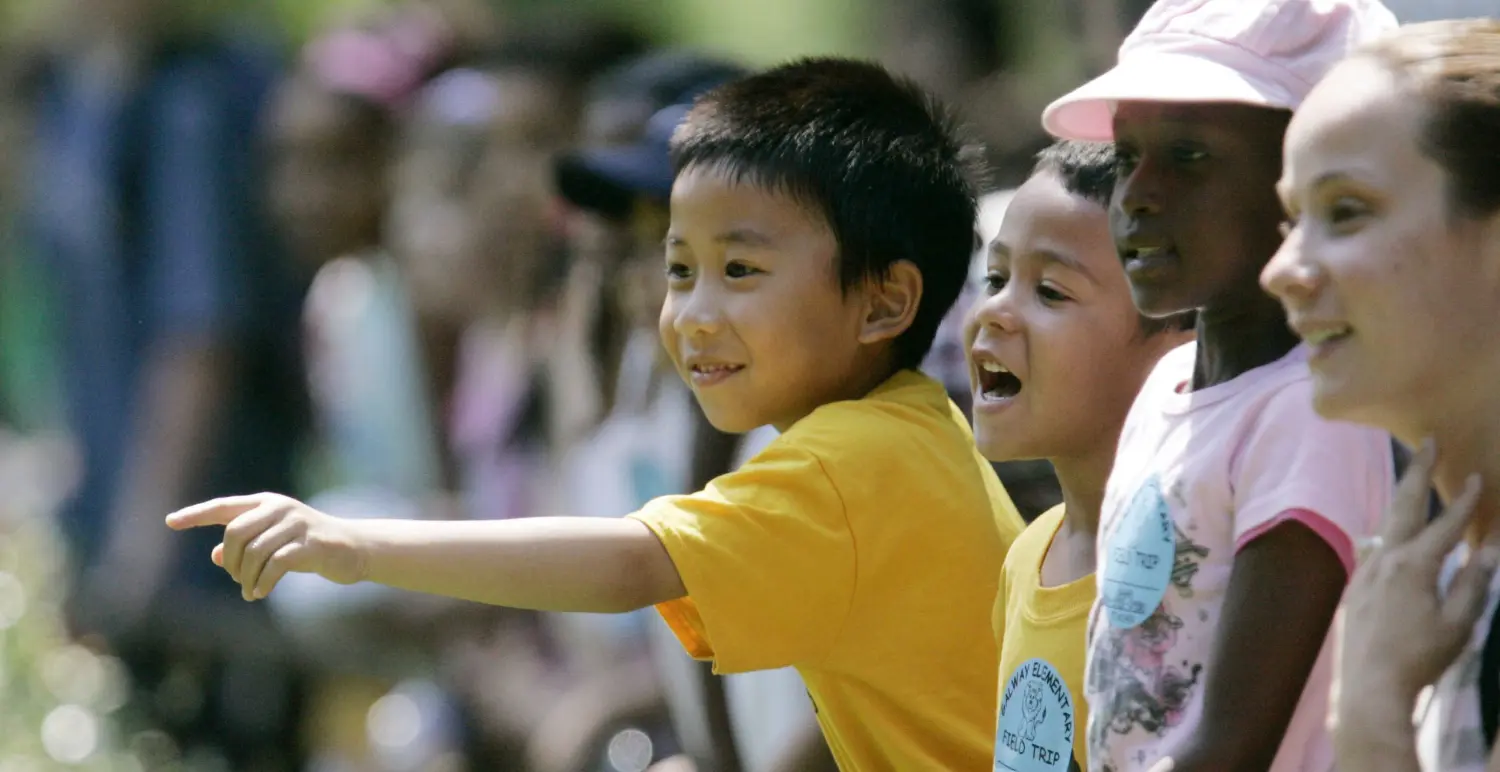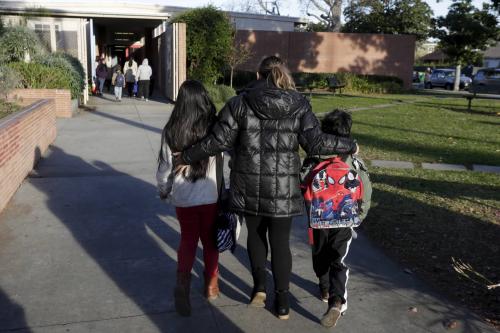The stark, stubborn race gaps in educational achievement undermine the American promise of equal opportunity. In particular, the divide between the test scores of white and black students reflects and reinforces unequal life chances.
Multiracial students: A neglected research subject
But not all students fall into single racial category. As Bill Frey shows in his book Diversity Explosion, there has been a rapid increase in the numbers of multiracial couples and children. In 1980, only 3.2 percent of U.S. marriages were between races; by 2010, that number had grown to 8.4 percent, including 15 percent of new marriages in 2015, according to Frey. A sizable and increasing share of U.S. children will think of themselves as multiracial over the next several decades.
Despite the growing number of multiracial students, almost no attention has been given to their educational outcomes. But gaining a better understanding of how multiracial students perform may cast useful light on the causes of race gaps more generally. My analysis shows that:
- Students of multiracial identity are from families with lower socioeconomic status than whites;
- They attend schools that are far more integrated with whites and Asians compared to blacks, Hispanics, American Indians, and Pacific Islanders;
- Multiracial students have the same average test scores as whites on math, science, and writing;
- For reading tests, multiracial students outperform other groups, including Asians; and
- These results contradict the controversial hypothesis that between group differences in IQ result from genetic differences between races.
These findings suggest that the race gaps in academic achievement in the United States are the result of inequality, especially in terms of access to educational opportunities, and therefore could be closed under fairer political, social, and economic arrangements.
Multiracial students are more likely to come from poorer families than single race students
Compared to mothers and parents of single-race non-Hispanic children, the mothers of multiracial non-Hispanic children are less likely to have a college degree, less likely to be married, take-in lower family incomes and were more likely to have been teenagers when they gave birth to their multiracial child. The percentage of children with at least one parent with a bachelor’s degree is lower. Fathers are also less likely to be present.
Not surprisingly, the family social status of multiracial children tends to fall somewhere in between that of single race non-Hispanic whites and blacks on each of these measures. I limit the analysis to non-Hispanics for the simple reason that Hispanic test score data are reported separately from every other group—including multiracial children, since Hispanic is considered an ethnicity rather than a racial group.
| Table 1. Family characteristics of non-Hispanic multiracial and non-Hispanic single-race students aged 15 to 18 who live with at least one parent | |||||
| Parents of white children | Parents of black children | Parents of multiracial children | Parents of single-race children | Difference mixed-race & single race | |
| Median family income | $118,107 | $58,686 | $72,800 | $80,700 | -$7,900** |
| Mother is single | 24.2% | 59.0% | 38.6% | 29.8% | 8.8%** |
| Mother was teenager during pregnancy | 4.7% | 12.7% | 7.5% | 6.0% | 1.5%** |
| Maternal bachelor’s degree attainment rate | 40.8% | 23.3% | 35.4% | 38.0% | -2.6%** |
| At least one parent in household has a bachelor’s degree | 49.3% | 26.4% | 43.2% | 45.6% | -2.4%** |
| No father in household | 18.0% | 54.4% | 31.9% | 24.1% | 7.8%** |
|
Source: Analysis of IPUMS-USA, 2015 American Community Survey. Notes: ** indicates significant at 99% confidence intervals. Sample is restricted to non-Hispanic population because test score data groups all Hispanic children together regardless of race and does not count them as multiracial if they identify as Hispanic. Sample is also restricted to children who are currently enrolled, live with at least one parent and are between the ages of 15 and 18 and drops a small number of observations in which the likely parent was identified as less than 25 years old (implying 7 to 10 at birth of child). Teen mom identified if mother is less than or equal to 35 years old, implying age 16 to 19 at pregnancy. |
|||||
Nearly half (46 percent) of multiracial students aged 15 to 18 report having black ancestry, and black-white combinations are the most frequent inter-racial origin of multiracial children in this age group. Still, white combinations with other races are also common, and 9 percent of multiracial students report having no white ancestry. I estimate that the average U.S. multiracial child 15 to 18 years old is roughly 45 percent white, 23 percent black, and 18 percent Asian, with further ancestral contributions from American Indians or Pacific Islanders. These patterns do not play out evenly across mothers and fathers. Multiracial children are about twice as likely to have a black father as they are to have a black mother, whereas Asian women are much more likely to parent multiracial children compared to Asian men. White women are only slightly more likely to parent a multiracial child compared to white men.
| Table 2. The most prevalent ancestral groups for multiracial students aged 15 to 18 | |
| Estimated share of ancestry | |
| White | 45% |
| Black | 23% |
| Asian | 18% |
| American Indian or Alaskan Native | 12% |
| Pacific Islander | 3% |
|
Source: Analysis of IPUMS-USA, 2015 American Community Survey. Sample is restricted to non-Hispanic population because test score data groups all Hispanic children together regardless of race and does not count them as multiracial if they identify as Hispanic. Sample is also restricted to children who are currently enrolled, live with at least one parent and are between the ages of 15 and 18. Shares are calculated by dividing mentions of each of five possible racial groups by the total number of racial groups indicated by the individual. The “other” racial group is excluded from the numerator and denominator. I also estimated these contributions using parental data, but that is limited to cases where both mothers and fathers were surveyed by the census. In such cases, blacks remain the second largest ancestral group (with 16 percent), but the contribution from non-Chinese or Japanese Asian and pacific Islanders becomes larger, roughly 10.5 percent. |
|
Multiracial children attend highly integrated into schools with whites and Asians
What kind of schools do multiracial students attend? The short answer is: those with high proportions of white or Asian students. At the average public high school attended by a multiracial student in the 2014-2015 school year, 60 percent of the students are white or Asian, which is comparable to the national share of white and Asian students of 57 percent. By contrast, at the average high school attended by black students only 33 percent of students are white or Asian and 32 percent for Hispanic students. American Indians are also segregated from whites and Asians, with only 44 percent of their classmates coming from those groups on average.
| Table 3. Degree of racial isolation and integration in U.S. public high schools by student race and Hispanic ethnicity, 2014-2015 | |||
| Average share of students at school attended | Share of total U.S. public school student population | Share of students who are white or Asian | |
| Multiracial | 5.1% | 2.6% | 59.9% |
| Pacific Islander | 17.4% | 0.4% | 47.2% |
| Asian | 20.6% | 4.9% | 59.9% |
| American Indian | 29.9% | 1.1% | 44.1% |
| Black | 46.2% | 15.7% | 32.8% |
| Hispanic | 52.3% | 23.3% | 32.4% |
| White | 71.5% | 52.1% | 75.2% |
|
Source: U.S. Department of Education, National Center for Education Statistics, Elementary and Secondary Information System, 2014-2015 school year; universe of schools restricted to those with at least one 12th grade student, to proxy for high schools. |
|||
Multiracial children are testing as well as whites
As of 2015, there is no test score gap between white and multiracial high school students; an important fact that, to my knowledge, has never been documented. My analysis is of data for 12th grade students from the National Assessment of Education Progress (NAEP). This is the largest nationally representative sample of cognitive performance in the United States, with approximately, 47,000 students (1.5 percent of all students) in public and private schools taking the exam. Of test-takers, about 2 percent (roughly 1000 students) are multiracial.1
There is no statistically significant difference between whites and multiracial students on tests in science, math, and writing. For reading, multiracial students slightly outperformed both white and Asian students, becoming the highest-performing racial or ethnic group with reported data by a small but statistically significant margin:
What’s more, my estimates suggest that multiracial students outperform the combined scores for single-race students on all subjects, despite coming from less advantaged families. Since the NAEP Data Explorer does not report precise sample sizes, these estimates are only rough and rely on a weighted average that applies demographic distributions from other Department of Education data sources—namely public high school students, where multiracial students comprised 2.6 percent of the total population.
A limitation of the analysis of socioeconomic status is that the data on family characteristics reported in Table 1 are from the American Community Survey, while the test score data are from the Department of Education’s NAEP. Both are meant to be representative of the U.S. population, but sampling issues may over- or under-state the true population values for test scores or socio-economic status.
As a check on these sampling issues, I compared the multiracial versus white test score gap from the NAEP to test score gaps from the 2016 California Assessment of Student Performance and Progress, which was taken by approximately 3.2 million public school students. From grades 3 to 11, mean test score gaps between multiracial and white students on both language and math were less than 0.1 standard deviations (and negative for 5th and 6th grade language), which I estimate to be well within the margin of error.2 Consistent with the Census data, multiracial students are also 6 to 9 percentage points more likely to be classified by the state of California as “economically disadvantaged,” meaning their parents are either poor, migrants, or lack a high school diploma, when compared to white students.
A revival of hereditarian theory in the Trump era
A group of academic psychologists and behavior genetics researchers subscribe to the view that racial differences in social status and cognitive performance have a substantial genetic component, in addition to environmental factors. Charles Murray’s infamous book with Richard Hernstein, The Bell Curve, popularized this view, known as hereditarian theory in the psychology literature.
There has never been any direct evidence in support of the idea that racial differences in cognitive performance are the result of genetic differences. At the individual level, twin studies suggest that genetics has some role to play in cognitive performance (40 percent is the mean estimate for hereditability across studies of U.S. residents), but the methodology of extracting hereditability estimates from twin studies suffers from many problems that likely inflate this number. Even with decades of research on twins, very little is actually known about the precise mechanisms through which genetic factors influence educational attainment and cognitive performance, or to what extent. Thus far, molecular biologists have been able to explain only 3.2 percent of variation in educational attainment and cognitive performance with genomic data, even in large sample sizes, though it is believed this figure will increase to as much as 20 percent as samples get larger.
At the group level, racial categories based on continental ancestral origins seem to have little if any genetic relevance. The hereditarians that Hernstein and Murray referenced never attempted to produce a coherent theory for group differences that are consistent with what is known about human evolution and population genetics. More recently, Nicholas Wade, a science journalist, has taken a stab at developing such a theory, but his ideas were not well received by population genetics and scholars of human evolution.
Nonetheless, the idea that group differences in themselves provide indirect evidence for genetic differences seems to retain popular support around the world, particularly among the so-called “alt-right.” It is not clear how one could reconcile theories of racial differences in genes for intelligence with the findings here that multiracial children score no lower than groups who are supposed to be genetically advantaged, even though they are born into families with lower socio-economic status—which hereditiarians argue is itself indicative of lower IQ.
Race and education: Multiracial students point the way forward
In the recent past of the Jim Crow era, there were few multiracial children, and so group outcomes were hard to study. But multiracial Americans are rising in numbers and growing in prominence: producing, in Barack Obama, our 44th President, to give one example. The academic success of multiracial students bodes well for the future, demonstrating how the integration of schools and of broader society can eliminate achievement gaps between groups of children, regardless of their race, or indeed their races.
The author did not receive financial support from any firm or person for this article or from any firm or person with a financial or political interest in this article. They are currently not an officer, director, or board member of any organization with an interest in this article.
-
Footnotes
- The NAEP collects and reports data on race using two distinct methods, one of which is based on school data (mostly from parents) and one based on student responses on the exam questionnaire. These sources are often in agreement, but for multiracial students, there appear to be a large number of non-matching cases. For that reason, I report the results using cases in which school administrative records match student self-reported categorizations. The main results showing little to no-gap with whites are robust using either only self-reported or only school-reported. Specifically, the average gap across domains (0.09 of a standard deviations) is equal to the average margin of error using only school-reported race, whereas there is a small gap (0.23 standard deviation units) using only student-reported race.
- I estimated margin of error using school level files, which reported mean test scores by ethnic group.





